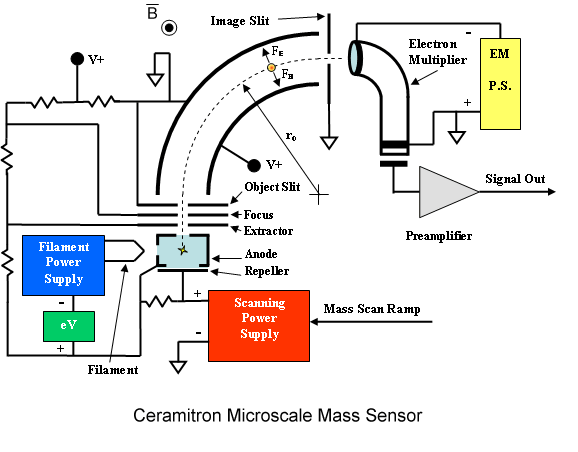| |

Check these unique sensor characteristics:
- Novel double-focusing magnetic sector mass spectrometer
- Superimposed magnetic and electric fields reduce ion path length
- Shorter ion path length allows higher operation pressure: ~10-4 Torr
- Photolithographic construction eliminates most discrete elements
- Ion source, analyzer, detector integrated into ceramic unibody enclosure
- Heated analyzer reduces sample contamination
- Low cost—disposable—“snap-in” sensor for easy field replacement
For a detailed explanation of sensor operation, see, for example:
- "Sub-miniature double-focusing mass spectrometer for in situ environmental
monitoring and application to volcanic gaseous emissions", Jorge A. Diaz, PhD Thesis,
University of Minnesota, July 1999.
- US Patents 6,590,207,
6,501,074 and 6,831,276
Advantages
Ceramitron's chief advantages derive from its small size, method of fabrication and intrinsically low cost.
| Feature |
Benefit |
| Smaller sensor geometry |
Smaller, less expensive power supplies with lower power consumption |
| Smaller footprint |
Lighter, more portable |
| Integrated ceramic housing |
Eliminates separate vacuum housing, lower construction cost |
| Lithographic internal elements |
Eliminates discrete elements, "perfect" registration, better uniformity, lower mfg. cost |
| Ceramic unibody construction |
Disposable sensor, lower service costs |
| Robotic construction |
Eliminates manual construction, improves uniformity |
| Low power consumption |
Better remote deployment with wireless networking, solar or battery power |
| Ruggedized construction |
Applications in harsh operating environments |
| Intrinsically low cost to produce |
Maximizes application versatility |
| Low-cost exclusive licensing |
Reduces time-to-market, lowers product development and overall life-cycle costs |
Sensor Operation

Description
Ions formed in the Anode volume by electrons produced by the Filament are
accelerated and focused by the Extractor and Focus lenses through the Object
Slit and into the 90° analyzer region of the sensor where the ion trajectories
become circular due to superimposed electric (E) and magnetic (B) fields.
The energy analyzer, shown in the drawing, resides within the gap of a "C-shaped"
permanent magnet, which applies a magnetic field at right angles to the radial
electric field. The magnetic field exerts an inward radial force, FB, on the
ions, whereas the electric field exerts an outward radial force, FE. When
FB = -2FE, a double-focusing condition is established that provides both energy
and momentum focusing of the ion beam, resulting in significantly improved resolution.
The Repeller provides a kinetic energy boost to low-energy, high mass ions to
improve extraction into the analyzer.
Resolving power is proportional to the analyzer radius, ro, and inversely proportional
to the widths of the Object and Image Slits: M/ΔM = (So + Si)/ro. Thus, for a
20mm radius sensor with 0.1mm slits, the resolving power is ~100, which means
that masses 99 and 100 would be resolved with ~10% valley between them (unit resolution).
The Scanning Power Supply determines the energy at which ions are formed while
providing operating voltages to the ion source, lenses and analyzer to maintain
double-focusing as the mass spectrum is scanned.
The Filament Power Supply heats the Filament to incandescence causing electrons to
fly toward the more positive Anode. The eV Power Supply sets the electron energy
(typically ~70eV) to a value that will ionize most of the neutral molecules inside
the Anode volume. A feedback circuit maintains a constant electron emission as the
filament ages.
Ions entering the analyzer region follow circular trajectories inversely proportional
to their mass-to-charge ratios. Ions traversing the centerline exit through the
Image Slit and are captured by the Electron Multiplier which amplifies the ion beam
current and sends it to the Preamplifier which produces an output voltage proportional
to the ion current and therefore to proportional to the relative abundance of the
selected ionic species. Scanning the sensor produces a series of output peaks, call
a mass spectrum, with each peak representing the relative abundance of each ion
species present in the gas sample introduced into the sensor.
Since a mass spectrometer detects any and all of the ions produced, it is a truly
universal gas analyzer that may be used in virtually scores of applications.
Mass spectral information may easily be generated by driving the Scanning Power
Supply from a digital-to-analog converter voltage ramp and recording the Signal
Out through an analog-to-digital converter, with both D/A and A/D programmed by
a dedicated microcomputer. Remotely deployed units may be accessed via a wireless
mesh network or through a wired TCP/IP, or similar, connection.
Non-mechanical Vacuum Pumps
Mass spectrometers must operate under vacuum to prevent ions from colliding with neutral
molecules in the flight path, thus preventing them from reaching the detector.
As the size of the sensor is reduced, so is the length of the ion flight path,
allowing the analyzer to operate at a much higher pressure without increasing
the collision frequency. A further path length reduction is accomplished in
the Ceramitron crossed-field sensor by superimposing the electric and magnetic
fields in the same analyzer volume, allowing units to operate at pressures > 10-4 Torr,
compared to 10-6 Torr required for larger units.
Most large commercial MS units use expensive turbo
molecular, diaphragm and rotary pumps to maintain vacuum. For novel applications
that do not require continuous input of gas samples, Ceramitron sensors accommodate
miniature non-mechanical pumping schemes including tiny ion pumps or getter pumps—such
as those available from SAES Getters—which can be integrated into the ceramic vacuum
housing, as describe in the patent. By periodically pulsing gas into the sensor at
a low duty cycle, the average internal vacuum is maintained, except during the
analysis portion of the cycle. Relatively long-term operation can be achieved
without contaminating the sensor.
Low-duty-cycle applications with gas samples periodically pulsed into the sensor
- Perimeter monitoring of chemical plants, oil fields or volcanoes
- Patient ventilator controller
- Battlefield, tunnel, building, airport antiterrorism countermeasures
- Weather balloon upper atmospheric profiling
- Submarine air quality monitoring
- Early fire detection in hotels, public buildings
|
|















